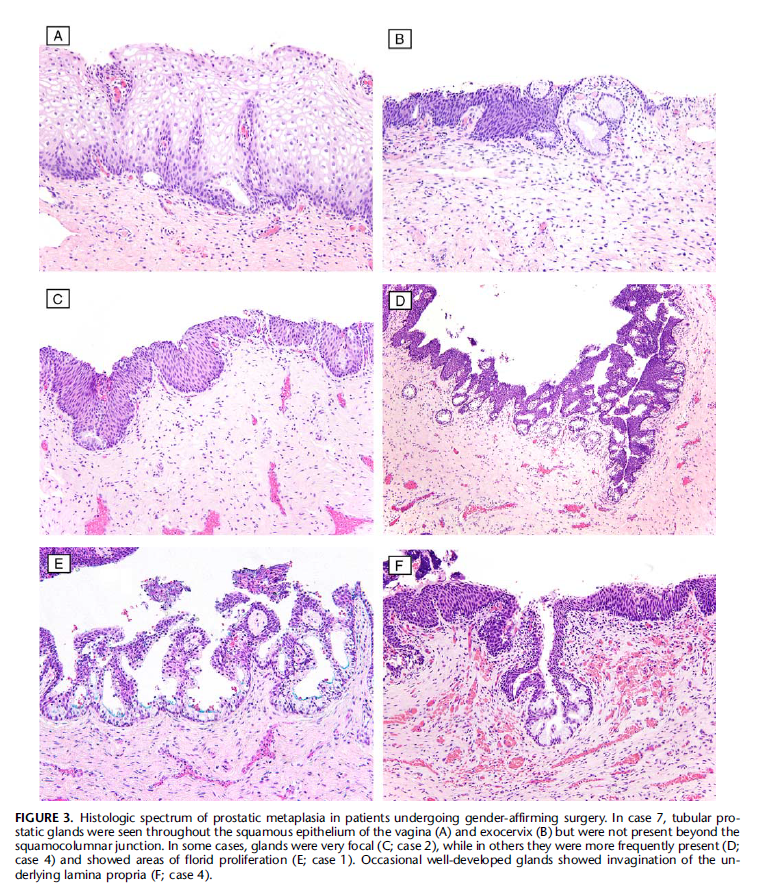 The general public’s knowledge of the nature of the physical changes induced by medical transition can be surprisingly spotty: trans women’s breasts are often wrongly assumed to be implants; our long-healed neovaginas are cruelly mischaracterized as “open wounds”; HRT is thought to be something we take merely for the sake of it rather than serving a functional purpose. In reality, cross-sex hormone therapy activates the expression of certain genes possessed by everyone whether assigned male or assigned female, and causes development of the associated secondary sex characteristics. Trans women taking estrogen will grow breast tissue with the same anatomy as that of cis women. The neovagina can differentiate into layers of cells highly similar to normal vaginal tissue (Grosse et al., 2017). And a recent study has reported on a “novel and previously unrecognized” finding: the growth of prostate tissue within the vaginal tract of trans men and transmasculine people taking testosterone.
The general public’s knowledge of the nature of the physical changes induced by medical transition can be surprisingly spotty: trans women’s breasts are often wrongly assumed to be implants; our long-healed neovaginas are cruelly mischaracterized as “open wounds”; HRT is thought to be something we take merely for the sake of it rather than serving a functional purpose. In reality, cross-sex hormone therapy activates the expression of certain genes possessed by everyone whether assigned male or assigned female, and causes development of the associated secondary sex characteristics. Trans women taking estrogen will grow breast tissue with the same anatomy as that of cis women. The neovagina can differentiate into layers of cells highly similar to normal vaginal tissue (Grosse et al., 2017). And a recent study has reported on a “novel and previously unrecognized” finding: the growth of prostate tissue within the vaginal tract of trans men and transmasculine people taking testosterone.
Anderson et al. (2020) examined tissue samples taken from eight trans men on testosterone who underwent vaginectomy (removal of the vaginal canal) as part of gender-affirming surgery, along with four intersex people with vaginas who had an excess of endogenously-produced androgens. In seven of the eight trans men, who had been receiving testosterone for an average of 43 months, very small “prostatic glands” were found distributed throughout the surface of the vaginal tissue, and some were characterized as “well-developed”:
These prostatic cells were found to express androgen receptors 100% of the time. Less frequently – in 69% of cases – the tissue was positive for prostate-specific antigen (PSA). The authors conclude that “characteristics of this lesion are most consistent with a form of androgen-mediated shift from squamous to prostatic differentiation”, and these prostatic glands were found in the intersex patients as well. They note that this reflects “the shared embryologic origin of the vagina and prostate from the urogenital sinus”, and “provides evidence that cervicovaginal epithelium can remain plastic into adulthood”.
This prostatic tissue, termed “androgen-associated prostatic metaplasia”, does not appear to present any risk to health. It is noted to have a “bland histologic appearance” and no patients experienced the growth of cancers or masses in the area at a followup time of up to 156 months, leading the authors to describe it as benign. What this phenomenon does demonstrate is that the sex characteristics of the human body are far from a matter of fixed and rigid binary distinctions – it is a system as fluid and complex as innumerable miniature prostate glands developing within the vaginal canal. ■





2 Responses to Trans men and transmasculine people on testosterone can grow prostate tissue